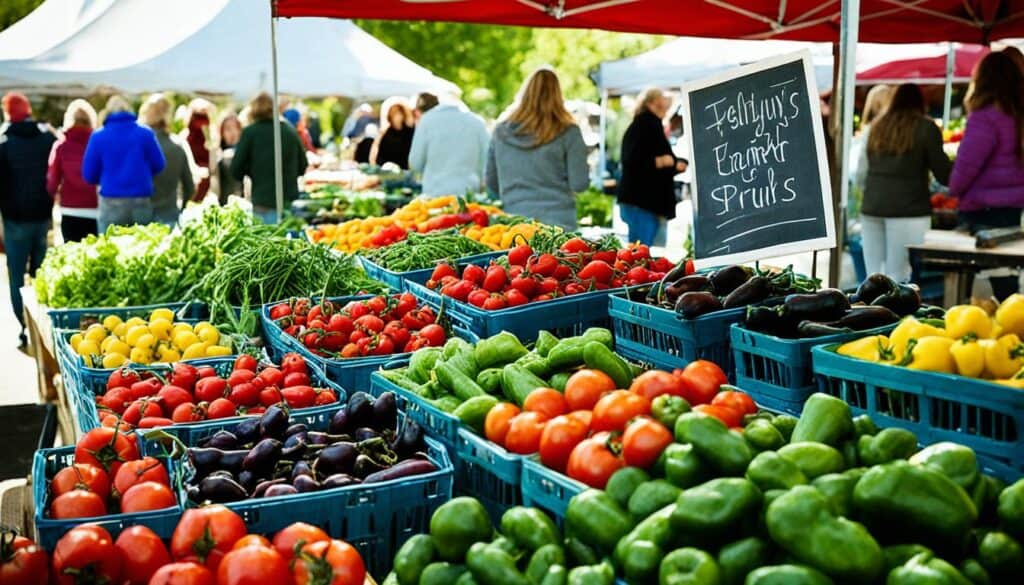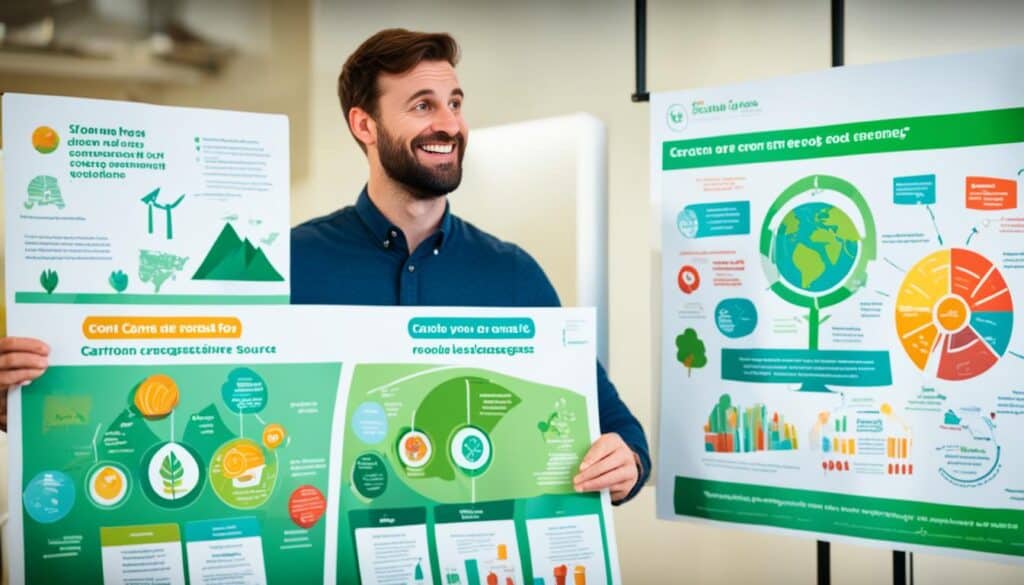Every one of us has the power to make a difference in combatting climate change and reducing our environmental impact. By taking personal actions, we can contribute to a cleaner, greener future. The choices we make today will have a lasting impact on our planet and future generations.
In this article, we will explore practical steps you can take to combat climate change and reduce your carbon footprint. From simple lifestyle changes to advocating for policy reforms, there are numerous ways you can make a positive impact. Let’s dive in and discover the actions you can take today to protect our planet.
As we delve into the different sections, we will discuss key topics such as raising your voice for climate action, shifting to a plant-based diet, choosing sustainable transportation, reducing energy consumption, minimizing car usage, eating locally and seasonally, preventing food waste, embracing sustainable fashion, planting trees and supporting restoration, shifting to planet-friendly investments, spreading climate awareness, involving the youth, and embracing a low-carbon lifestyle.
Each section will provide valuable insights and practical tips to help you make a difference. Together, we can combat climate change and create a sustainable future for generations to come.
Raise Your Voice for Climate Action

Political action and lobbying for climate change are vital in reducing carbon emissions and creating a sustainable future. By actively engaging with your elected representatives and local politicians, you can make a significant impact on environmental policies and advocate for the changes we need to combat climate change.
One of the most effective ways to get involved is by directly contacting your elected officials. Write letters, send emails, or make phone calls to express your concerns about climate change and the importance of reducing carbon emissions. Share relevant data, scientific evidence, and personal stories to illustrate the urgency of the matter.
Furthermore, participating in local and national campaigns focused on environmental issues can amplify your voice and make a greater impact. Join social movements, sign petitions, and attend rallies or protests to support initiatives that prioritize climate action. By uniting with like-minded individuals, we can collectively push for change and demand policies that reduce our carbon footprint.
Inspiring Others to Take Action
- Encourage friends, family, and colleagues to get involved in climate action by educating them about the importance of reducing carbon emissions and promoting sustainable practices.
- Use social media platforms to share information, resources, and success stories to raise awareness about the impact of climate change and the actions we can take.
- Organize or participate in community events, workshops, or webinars focused on environmental issues to engage others in discussions and promote environmental consciousness.
Raising your voice for climate action is not just about individual efforts; it’s about coming together as a global community to drive change. By actively participating in political processes and inspiring others to do the same, we can create a more sustainable and resilient future for generations to come.
Shift to a Plant-Based Diet

Eating less meat and dairy products is one of the most effective ways to reduce your environmental impact. The production of meat and dairy contributes significantly to greenhouse gas emissions, deforestation, and water pollution. By reducing your meat consumption, you can help mitigate climate change and support sustainable agriculture.
Plant-based diets have been proven to have numerous health benefits, including lower risk of heart disease, diabetes, and certain cancers. By incorporating more fruits, vegetables, legumes, and whole grains into your meals, you can improve your overall well-being while making a positive impact on the planet.
Support sustainable agriculture by buying local and seasonal foods. This reduces the carbon footprint associated with long-distance transportation and supports local farmers. Choose organic and regeneratively grown produce whenever possible to promote environmentally friendly agricultural practices. Additionally, reducing food waste by planning meals and utilizing leftovers can further minimize your environmental impact.
Choose Sustainable Transportation

Transportation plays a significant role in greenhouse gas emissions, making it crucial to opt for sustainable alternatives. By decarbonizing travel and embracing eco-friendly transportation options, we can make a positive impact on the environment. Here are some actions you can take today to reduce your carbon footprint:
1. Use Public Transport
Take advantage of public transportation systems such as buses, trains, and trams whenever possible. Public transport not only reduces individual carbon emissions but also helps alleviate traffic congestion and promotes community connectivity.
2. Choose Walking and Cycling
For short distances, opt for walking or cycling instead of using a car. Not only is it a sustainable mode of transportation, but it also offers health benefits while reducing traffic and air pollution.
3. Consider Electric Cars
If you need a car for longer journeys or daily commuting, consider switching to an electric vehicle (EV). Electric cars produce zero tailpipe emissions, significantly reducing their carbon footprint and dependence on fossil fuels. Alongside the growing charging infrastructure, EVs contribute to decarbonizing the transportation sector.
4. Carpool and Ride-Sharing
Reduce carbon emissions by carpooling with colleagues, neighbors, or friends who have similar commuting routes. Ride-sharing platforms also provide an opportunity to share rides and lower individual emissions while optimizing vehicle occupancy.
5. Limit Long-Haul Flights
Long-haul flights contribute significantly to carbon emissions. Whenever possible, consider alternative modes of transportation such as trains or buses for regional or domestic travel. If flying is unavoidable, opt for direct flights and consider purchasing carbon offsets to mitigate your environmental impact.
By actively choosing sustainable transportation options like public transport, walking, cycling, electric cars, carpooling, and limiting long-haul flights, we can collectively contribute to the decarbonization of travel and help combat climate change.
Reduce Energy Consumption

Reducing your energy consumption is a crucial step towards combating climate change and transitioning to a sustainable future. By implementing simple changes in your daily habits and making thoughtful choices, you can significantly lower your carbon footprint and contribute to a greener planet.
1. Turn down the thermostat
One effective way to reduce energy consumption is by adjusting your home’s thermostat. Lowering the temperature during colder months and raising it during warmer months can save energy and reduce carbon emissions. Not only will this help the environment, but it can also save you money on heating and cooling costs.
2. Use energy-efficient appliances and light bulbs
Investing in energy-efficient appliances and light bulbs not only reduces your energy consumption but also decreases your utility bills. Look for appliances with the ENERGY STAR label, which indicates that they meet strict energy efficiency standards. Similarly, opt for LED or CFL light bulbs that use significantly less energy and last longer than traditional incandescent bulbs.
3. Insulate your home
Proper home insulation is essential for maintaining a comfortable indoor temperature and minimizing energy waste. Insulating your walls, floors, and attic prevents heat transfer, reducing the need for excessive heating or cooling. This not only saves energy but also enhances the overall energy efficiency of your home.
4. Switch to renewable energy providers or install solar panels
Transitioning to renewable energy sources is another effective way to reduce your carbon footprint. Consider switching to a renewable energy provider that supplies your electricity from wind, solar, or hydroelectric power. Alternatively, if feasible, installing solar panels on your property can generate clean and sustainable energy while further reducing your reliance on fossil fuels.
Incorporating these energy-saving practices into your lifestyle can have a significant positive impact on the environment and help pave the way towards a more sustainable future.
Minimize Car Usage

When it comes to reducing carbon emissions and improving air quality, minimizing car usage is a crucial step. Instead of relying on cars for every trip, consider alternative modes of transportation that are more sustainable and eco-friendly. Here are some options to consider:
- Walking: For shorter trips, opt for walking whenever possible. Not only is it a great form of exercise, but it also produces zero emissions, making it an excellent choice for both your health and the environment.
- Cycling: Another environmentally friendly option is cycling. Whether it’s commuting to work or running errands, cycling can be a fun and efficient way to get around while significantly reducing your carbon footprint.
- Public Transport: For longer journeys or when walking or cycling is not feasible, consider using public transport. Buses, trains, and trams are often more energy-efficient than individual cars and can help decrease congestion on the roads.
- Car-Sharing: If you do need to use a car, explore car-sharing schemes in your area. Sharing a ride with others going in the same direction can help reduce the number of vehicles on the road, leading to fewer emissions.
- Electric Vehicles: Consider switching to an electric vehicle (EV) for your daily commuting or other transportation needs. EVs produce zero tailpipe emissions, helping to reduce air pollution and dependence on fossil fuels.
By incorporating walking, cycling, car-sharing, and electric vehicles into your daily routine, you can significantly contribute to reducing carbon emissions and promoting a cleaner and healthier environment.
Eat Locally and Seasonally

One of the most impactful ways to reduce your carbon footprint and support sustainable farming practices is by eating locally and seasonally. By purchasing fresh, locally sourced produce, you not only reduce the distance that food has to travel but also support local farmers and the local economy.
Buying local food helps to reduce food miles, which are the distance that food travels from the farm to the consumer. When we buy food that is grown or produced nearby, we minimize the carbon emissions associated with long-distance transportation. This is because food transported over long distances often requires energy-intensive processes such as refrigeration and packaging. By opting for local food, we can significantly reduce greenhouse gas emissions and promote more sustainable agricultural practices.
Another benefit of eating locally and seasonally is that it allows us to enjoy fresh, flavorful produce that is at its peak ripeness. Locally sourced fruits and vegetables are typically harvested when they are fully ripe and have had the chance to develop their full flavor. This enhances the taste and nutritional value of the food we consume, making it a more enjoyable and healthier choice.
Supporting Sustainable Farming
When we eat locally and seasonally, we also support sustainable farming practices. Local farmers often prioritize sustainable farming techniques such as organic farming, crop rotation, and biodiversity preservation. These practices contribute to the conservation of soil health, reduce dependence on synthetic fertilizers and pesticides, and promote a more balanced and resilient ecosystem.
By getting involved in community-supported agriculture (CSA) programs or purchasing produce from farmer’s markets, we can directly support these sustainable farming practices. These alternative food systems emphasize the importance of reducing our environmental impact and ensuring the long-term viability of our food production systems.
In addition to buying local produce, consider growing your own herbs and vegetables or participating in community gardens. This not only provides an opportunity to connect with nature but also allows you to have greater control over the quality and sustainability of your food. Growing your own food and participating in local gardening initiatives can be a rewarding way to reduce food miles and promote a more sustainable lifestyle.
Benefits of Eating Locally and Seasonally:
- Reduces carbon emissions associated with food transportation
- Supports local farmers and the local economy
- Promotes sustainable and organic farming practices
- Provides fresher, more flavorful produce
- Encourages healthier eating habits
- Strengthens community connections
By choosing to eat locally and seasonally, we not only make a positive impact on the environment but also reap the benefits of fresh, nutritious, and flavorful food. It’s a win-win situation for both our health and the planet.
Prevent Food Waste

Approximately one-third of all food produced is wasted, contributing to greenhouse gas emissions. Preventing food waste is not only beneficial for the environment but also for your wallet. Here are some simple steps you can take to reduce food waste:
- Buy only what you need: Plan your meals and make a grocery list before going shopping. This will help you avoid purchasing excess food that may spoil before you have a chance to eat it.
- Use leftovers creatively: Instead of tossing out leftover food, repurpose it into new meals or use it as ingredients for other dishes. Get creative in the kitchen and experiment with new recipes.
- Participate in local food-sharing schemes: Look for community initiatives or food-sharing programs in your area that connect individuals or organizations with excess food to those in need. By donating excess food, you can help reduce waste and support your community.
Composting is another effective way to manage food waste and reduce its impact on the environment. Composting inedible remnants such as vegetable peels, coffee grounds, and eggshells can help divert organic waste from landfills. This process allows the organic waste to decompose naturally, turning it into nutrient-rich compost that can be used to fertilize gardens and plants.
To learn more about composting, check out the image below:
Choose Sustainable Fashion

The fashion industry is a significant contributor to carbon emissions, and the rise of fast fashion has fueled a throwaway culture that often neglects environmental responsibility. However, there are steps you can take to make a positive impact on the planet through your fashion choices.
One of the most effective ways to support sustainability in fashion is to buy fewer new clothes. By embracing a more mindful approach to shopping, you can prioritize quality over quantity and invest in timeless pieces that will last for years to come.
When adding to your wardrobe, opt for sustainable and ethical clothing brands. These brands prioritize fair labor practices, use eco-friendly materials, and often support social and environmental causes. By choosing these brands, you are supporting a more ethical and environmentally conscious fashion industry.
Another option to explore is renting clothes for special occasions. This reduces the demand for new clothing items and allows you to enjoy fashionable outfits without the need for long-term ownership. Many online platforms offer clothing rental services, making it easy to find the perfect outfit for any event.
To further extend the lifespan of your clothing, consider recycling or repairing items when necessary. Clothing recycling programs help divert textiles from landfills and often give them a new life as new products or materials. If an item can still be worn but needs a little TLC, explore local tailors or DIY repair options to give it a second chance.
By choosing sustainable fashion practices, you can minimize your impact on the environment and contribute to a more responsible and conscious fashion industry.
Plant Trees and Support Restoration

Deforestation is a major contributor to greenhouse gas emissions. The loss of forests not only releases carbon dioxide into the atmosphere but also disrupts ecosystems and threatens biodiversity. To combat this, individuals and communities can contribute to reforestation efforts and support ecosystem restoration.
Planting trees is a powerful way to sequester carbon dioxide and restore natural habitats. Whether you plant trees on your property or participate in collective initiatives, every new tree makes a positive impact on the environment.
One way to get involved is by exploring the UN Decade on Ecosystem Restoration. This initiative aims to accelerate efforts to halt ecosystem degradation and restore damaged ecosystems around the world. By joining this global movement, you can play a part in preserving biodiversity and combating climate change.
Additionally, you can inquire about tree-planting initiatives in your area. Many organizations and local governments organize planting events or offer resources to support reforestation efforts. Participating in these initiatives allows you to contribute to the restoration of ecosystems in your community.
Supporting restoration efforts not only helps combat climate change but also protects biodiversity. Ecosystem restoration creates thriving habitats for a wide variety of plant and animal species, promoting a healthier and more balanced natural ecosystem.
By taking action in reforestation and ecosystem restoration, we can safeguard the planet’s natural resources, mitigate climate change, and preserve the incredible diversity of life on Earth.
Shift to Planet-Friendly Investments

When it comes to combating climate change, our individual actions are crucial. However, we can also make a significant impact through sustainable investments and responsible banking. By using our savings and investments to support financial institutions that prioritize sustainability, we can contribute to a more sustainable future.
One key aspect to consider is divestment from fossil fuel-related investments. Divesting from industries that contribute to carbon pollution can send a powerful message and help accelerate the transition to a low-carbon economy. Instead, choose to support companies that are aligned with addressing climate change and investing in sustainable alternatives.
Research is essential when making planet-friendly investment decisions. Look for banks and investment firms with responsible banking policies that integrate environmental, social, and governance (ESG) factors into their decision-making processes. These institutions are committed to sustainable practices and can offer a range of investment options focused on sustainable development.
By shifting to planet-friendly investments, we can align our financial resources with our commitment to the environment. Sustainable investments not only provide an opportunity for financial growth, but also help drive the transition to a more sustainable future.
Spread Climate Awareness

Help combat climate change by spreading awareness and encouraging others to reduce their carbon footprint. By joining global movements and campaigns focused on climate action, you can inspire individuals to take individual action and engage in the critical global debate.
For example, consider participating in initiatives like Count Us In and the UN’s #ActNow campaign. These global movements offer opportunities to connect with like-minded individuals, access informative resources, and share success stories that motivate others to make a difference in their own lives.
To effectively spread climate awareness, share information about the causes and impacts of climate change, as well as practical solutions for mitigation and adaptation. Use social media platforms, blogs, and other communication channels to reach a wider audience and generate meaningful conversations.
Remember to highlight the importance of climate education in empowering individuals to make informed decisions and take positive action. By sharing accurate, reliable information and resources, you can help others understand the urgency of addressing climate change and inspire them to join the movement for a sustainable future.
By actively spreading climate awareness and encouraging global movements, we can create a collective impact and drive positive change at a larger scale. Together, let’s inspire individuals around the world to take proactive steps towards a more sustainable future.
Involve the Youth

Engage and empower young people in climate action by involving them in the fight against climate change. By providing opportunities for youth to raise their voices, participate in campaigns, and contribute to decision-making processes, we can create a powerful movement for positive change.
One crucial aspect of involving the youth is through climate education in schools. By integrating climate change curriculum into their studies, we can equip future generations with the knowledge and understanding they need to address environmental issues effectively.
Supporting youth-led initiatives such as the Youth Strike 4 Climate is another impactful way to involve the younger generation. By standing alongside these passionate activists, we show our solidarity and amplify their message, inspiring others to take action.
Young people have a unique perspective, creative ideas, and boundless energy. By providing them with platforms to express their concerns, they can contribute to shaping policies, strategies, and initiatives aimed at combatting climate change.
Empowering future generations is essential for building a sustainable and resilient future. Let us listen to the voices of the youth, support their initiatives, and work together to create a better world for everyone.
Embrace a Low-Carbon Lifestyle
To combat climate change and create a sustainable future, it’s essential to embrace a low-carbon lifestyle. By adopting eco-friendly choices and sustainable habits in all aspects of our lives, we can make a significant impact on the environment.
One key element of sustainable living is practicing mindful consumption. By making conscious choices about the products we purchase, opting for eco-friendly alternatives, and supporting brands that prioritize sustainability, we can reduce our carbon footprint.
Another crucial aspect is waste reduction. Implementing practices such as recycling, composting organic waste, and avoiding single-use plastics can significantly decrease the amount of waste that ends up in landfills or pollutes our oceans.
Furthermore, supporting renewable energy sources is vital in our transition to a low-carbon lifestyle. By investing in renewable energy technologies and advocating for their use, we can accelerate the shift towards a more sustainable and cleaner energy future.
Ultimately, promoting biodiversity is crucial in maintaining the delicate balance of our ecosystems. By preserving natural habitats, planting trees, and supporting conservation efforts, we can protect biodiversity and ensure a healthy planet for future generations.
By embracing a low-carbon lifestyle and making sustainable choices, we have the power to combat climate change and safeguard the future of our planet. Let’s lead by example, inspire others, and work together towards a more sustainable and eco-friendly world.
 Fullersears
Fullersears





